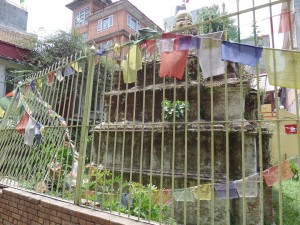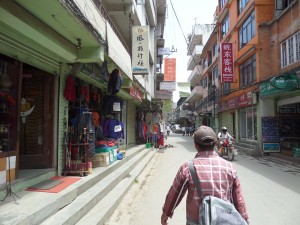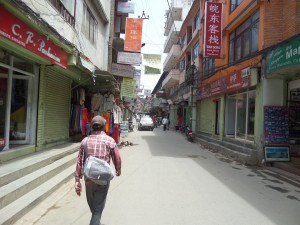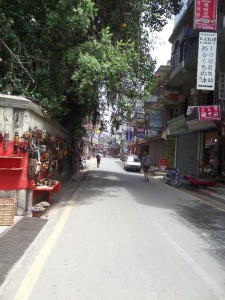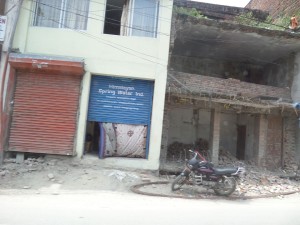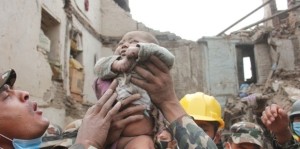I leave for Kathmandu, Nepal early tomorrow morning. As is typical of travel from the U.S. to South Asia, I will be negotiating flights for roughly two days of travel time. Once there, it will be another week before I reach my fieldsite in Mustang District. As we ascend higher and higher into the Himalayas, we’ll be first stopping to acclimatize in Pokhara and then in Jomsom, before making the final leg by jeep to Muktinath.
Describing my fieldsite has always been a bit of a challenge for me. Muktinath is a complicated place, embedded in complicated space, and I have not yet found, I think, the best sequence with which to describe it. In other words, I’m often at a loss as to what aspect I should describe first since I continuously feel the need to explain why something is important before I can even tell someone what it is. Imagine the problem a bit like finding two old photographs, full of people you do not recognize, in a shoe box. While both photos are beautiful, one photo has a description written on the back of it including names, dates, and places that everyone seems to know. The other has nothing. In the meantime, I’m trying to describe an album full of photos with nothing written on them.
Good advice for future generations I suppose; document your photos, kids.
In that vein, as I set off to begin my fieldwork in Nepal, I think it’s high time I contextualized all of this a little. So, here is something of an explanation of Muktinath, Nepal:
Mustang District is located in Nepal’s Dhaulagiri Zone, along the western ridge of the Himalayan Annapurna mountain range. Founded as the Kingdom of Lo in AD 1440. Mustang is currently divided into upper (northern) and lower (southern) regions. These distinctions are both locally and nationally defined, and have tremendous economic, social, political, and cultural ramifications partially due to the fact that Upper Mustang is still restricted to foreign travel and Lower Mustang only opened to travelers in 1992. However, the internal divisions, dialects, and distinctions of Mustang’s populace are much more complex than this binary division might imply. For example, Mustang is also home to the Baragaon settlement area which is comprised of speakers of primarily Nepali-Tibetan dialects located in and around the Muktinath Valley, and the Lode Tshodun, the seven principalities of the kingdom of Lo, a Tibetan-speaking area of which the walled city of Lo Monthang is the capital.
The village of Kagbeni marks the division between upper and lower Mustang in that foreigners are not allowed to travel north beyond Kagbeni without special permits. The reasons behind these continued closures is politically complex. The entire region encompassed today by the Mustang District, and in particular the Kali-Gandaki River Valley, has been a locus of trans-Himalayan trade for centuries, particularly in the exchange of lowland grains for Tibetan salt. However, since its consolidation in 1789 during the Gorkhali conquests and until the Chinese occupation of Tibet in 1959, Mustang had maintained strong cultural and economic ties to the old kingdoms of Tibet, Bhutan, and West Bengal. Today, considered an important buffer region between Chinese-occupied Tibet, the Kathmandu Valley, and India, Mustang has maintained a certain degree of local autonomy but has continued to struggle economically in political isolation. In addition, and not surprisingly, given its historical, linguistic, and ethnic ties to Tibet, its position as the base of operations for the Tibetan resistance in the 1960s, as well as the large numbers of Tibetan refugees still living in the region, Mustang is quite often problematically characterized in both travel literature and in academic discourse as “the Lost Kingdom of Tibet.”
In light of Nepal’s long-standing struggles with inter-regional conflict, civil war, and political instability, the central government of Kathmandu has positioned itself as a culturally homogenizing force in the spirit of national unity. Since the unification of Nepal under the Sugauli Treaty of 1816, and the ratification of the civil code called the Muluki Ain, the central government has defined Nepaliness through three principal criteria: speaking Nepali, adopting the Daura Suruwal style of dress, and practicing Vaishnava Hinduism. (Vaishnavism or Vaishnava Dharma, is one of the major branches of Hinduism common in India, Nepal, Bangladesh, and Sri Lanka. It is focused on the veneration of Vishnu as a supreme deity. Vaishnava traditions then comprise multiple variant forms of polymorphic monotheism and henotheism but all of which give primary importance to Vishnu and his ten incarnations.) Three categories of political belonging which are not exemplified by Mustang District in general, or the Muktinath Valley region specifically; who tend to speak a combination of Hindi, Nepali, and Tibetan, wear Himalayan styles of dress, and practice three historically and discursively separate religious traditions syncretically (Hinduism, Buddhism, and Bonpo/Bön). It is within this historical, political, and economic landscape that the Hindu-Buddhist pilgrimage site of Muktinath is situated.
Muktinath-Chumig Gyatsa (Mukinath being the Indian/Hindu name for the site, meaning “Lord of Salvation,” and Chumig Gyatsa being the Tibetan/Buddhist name for the site, meaning “Hundred Waters”) sits at 3750m above sea level just below the Thorong La mountain pass in Lower Mustang along the western slopes of the Damodar Himal, a northern extension of the Annapurna and Dhaulagiri mountain peaks. While the main draw of the temple site is the Mandir of Vishnu (Hindu Vaishnava), both the temple and the mountain pilgrimage route contain numerous important shrines to Shiva (Hindu Shaivite) as well as Buddhist stupas. As a sacred landscape, Muktinath is even more contentious.
Textual sources drawn from both Hindu and Buddhist traditions alternatively place “Muktinath” (or alternatively “Muktiksetra”) near the source of the Kali-Gandaki river (some 4000m higher up the mountain) or in the mythic region called Salagrama (an indigenous term for the area that will have special significance in a moment) which is variously placed in central Nepal, elsewhere in the Annapurna range, or near the Trisuli river in highland Tibet near the Chinese border. This ambiguity highlights our first contention at Muktinath. That being the contention of Muktinath’s “real” location which I argue is likely indicative of its religious position as a Buddhist-Hindu syncretic site and indicative of the problematic characterization of the primarily Nepali Hindu Annapurna pilgrimage circuit by tourist literatures as essentially “Buddhist/Tibetan.” These particular tensions often revolve around a historical record that documents Muktinath as having been a Hindu pilgrimage destination as far back as AD 300 before being incorporated into the Buddhist revival of pilgrimage sites in the area sometime in the late 8th century AD. These textual ambiguities are also unsettled in practice through the modern Buddhist understanding of the deity of Vishnu at Muktinath as also being that of an incarnation of the patron bodhisattva of the nation of Tibet, AvalokiteÅ›vara. This is because the vast majority of pilgrims who visit the site are comprised mainly of Hindi or Nepali-speaking Vaishnavas (from primarily central Nepal or northern India) while the permanent residents of the nearby villages (such as the main pilgrimage stop, Ranipauwa) remain split between Nepali-speaking Pahari (“hill people”), the Tibeto-Burmese-speaking but ethnically Nepali Thakali peoples, and the Tibetan-speaking Bhotia of Baragaon who migrated not from Tibet, but from other regions of Nepal.
The issue of religious syncretism is also a primary one. Though I won’t go into depth here about the discursive problems of the term “religious syncretism,†(See my interview on “This Anthropological Life” for more in-depth discussion of this term) religious co-participation is one of Muktinath’s primary features. What does that mean? In general usage it means that the people of Muktinath simultaneously practice more than one religious tradition (Buddhism, Hinduism, and Bonpo/shamanism). However, I argue that these traditions and spiritual ontologies are not being reconciled into new hybrid forms, but are, instead, held in continuous contention. What is more, often times this contention is articulated in national terms. What I mean by this is that Hinduism is often coded as distinctly Indian, Buddhism as Tibetan, and Bonpo as Nepali.
So who goes there? – Pilgrims to Muktinath are primarily North Indian or Eastern Nepali Hindus, and somewhat fewer Buddhists from southern Tibet. Also, somewhat surprisingly, Muktinath is not run by either Buddhist monks or by Hindu brahmacharya as is typical of significant pilgrimage places similar to Muktinath. Rather it is run primarily by a resident order of Buddhist nuns of Nyingmapa/Lama Wangyal sect. This point is particularly interesting because neither Mahayana or Theravada Buddhism nor Vaishnava Hinduism allow women to maintain religious authority not are other pilgrimage sites similar in scale and prestige to Muktinath run in this way. Female practical authority, however, is known among practitioners of shamanism, including the local traditions of Bonpo.
This articulation with shamanism and Bön practices is important on a national scale because it situates Muktinath within the larger Hindu-Buddhist-shamanistic ritual system that is prevalent among Nepal’s hill communities and which may also reveal broader uses of religious syncretism for negotiating identity in the Himalayan regions. In this way, the complicated linkages of transnational religious and gendered identities and structures of power that continue to affect the ascetic women (Buddhist nuns) who live and work at Muktinath complicates the site’s religious and ritual positions vÃs-a-vÃs the local Nepali residents and the international and transnational pilgrims drawn to the temple site. This is important because I ask whether the nuns may represent a continuity of Bön practice, or, if their practical authority at Muktinath may demonstrate enough of a deviation from orthodox Hindu and Buddhist practices that possible religious claims to the site become problematic, or perhaps a little of both.
But the enduring and over-arching draw for pilgrims, domestic and transnational, actually lies a few hundred meters higher up the mountain at the source of the Kali-Gandaki river, the Damodar Kund, a lake which sits at roughly 8000m and whose ancient shale beds are the source of the sacred Shaligram Stones.
Since at least the 5th c. B.C.E., the veneration of sacred fossil ammonite stones has been a prevalent feature of both Hindu and Buddhist ritual practices throughout South Asia. Even today, Muktinath remains the sole geographic source for these stones, called Shaligram Shila, venerated as the naturally occurring manifestation of Sriman Narayan (Lord Vishnu) and his avatars. To Buddhist practitioners, these stones are often read as manifestations of various kinds of celestial beings or occasionally, as parts of the Buddha himself. Ritual and religious uses of the stones are widely varied, and include use in public shrines, in home worship, in festival events, and for exchange during major life events such as weddings and funerals. Shaligram stones are primarily found in along the river banks, and in the tributaries offshoot lakes, of the the Kali-Gandaki river. This particular association with rivers is especially important given the view in many South Asian religions that rivers often constitute a sacred bridge (tirtha) between the material and divine worlds. Thusly, the parallels between a stone that “travels” into the mortal world and pilgrims who “travel” into divine worlds through movement across landscapes is also symbolically significant.
In the discourses of science, Shaligram Stones are comprised of three species of fossil ammonites that originate in the shale beds of the Damodar Kund. They date specifically from the Early Oxfordian to the Late Tithonian age near the end of the Jurassic period some 165-140 million years ago. But this kind of discourse is largely absent from the religious discourse of pilgrimage and among the pilgrims themselves who journey to Muktinath to obtain the stones. Suffice to say, Shaligram Stones constitute a primary draw for religious pilgrims to the temple valley and accordingly have been one of the major sources of income (either by catering to the food and housing needs of pilgrims or by selling the stones directly) for residents of the region. Shaligrams then, and their significant draw in terms of pilgrimage, serve as a focus of national and international commerce within the region even though their exchange is positioned in religious terms. And it is here that I am just beginning.
See? I told you it was complicated.

